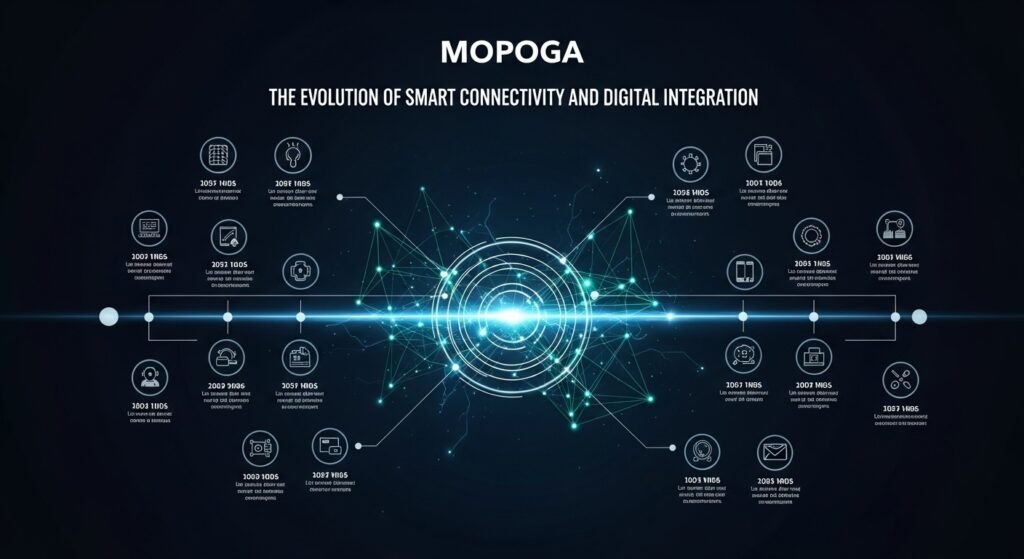Have you ever heard of something called mopoga? If not, you’re not alone. It’s a term that is slowly starting to appear in conversations about technology, digital media, and online interaction. Think of it as a new way people are connecting and sharing information. It blends social elements with practical tools, creating a unique digital space. Understanding mopoga now can help you get ahead of the curve as this concept continues to grow. It’s not just another app or website; it’s a framework for how different digital services can work together more smoothly. This guide will walk you through everything you need to know, from its basic definition to its potential impact on our daily lives. We’ll explore what it is, how it works, and why you should care about it.
Key Takeaways
- What is Mopoga? Mopoga is an emerging digital framework that combines social networking features with utility-based applications to create integrated online experiences.
- Core Components: It’s built on three pillars: community interaction, functional integration, and a personalized user experience.
- Why It Matters: Mopoga has the potential to simplify our digital lives by bringing disconnected apps and services into a more unified and efficient environment.
- Real-World Impact: From managing smart homes to organizing community events and enhancing educational platforms, the applications of mopoga are vast and practical.
- The Future is Integrated: As technology evolves, concepts like mopoga represent a shift towards more seamless and user-centric digital ecosystems.
Decoding Mopoga: What Does It Really Mean?
So, what exactly is mopoga? At its core, mopoga is a concept for an integrated digital environment. Instead of having separate apps for socializing, productivity, smart home control, and entertainment, mopoga imagines a world where these functions are woven together. It’s a hybrid model that pulls the best from social media platforms and combines it with the utility of standalone applications. Imagine a single platform where you can chat with friends about a project, and within that same chat, you can access and collaborate on documents, schedule meetings in a shared calendar, and even order lunch without ever leaving the conversation.
This idea of integration is key. The goal of mopoga is to reduce the friction we experience when switching between dozens of different apps on our phones and computers. It’s about creating a more streamlined and context-aware digital life. The term itself is a placeholder for this growing trend, much like “the cloud” was before it became a household name. By focusing on a unified experience, mopoga aims to make technology feel less fragmented and more intuitive. It’s less about a single product and more about a philosophy of how our digital tools should work together for us.
The Origins and Evolution of the Mopoga Concept
The idea behind mopoga didn’t appear overnight. It has evolved from years of observing how people use technology. In the early days of the internet, websites and services were very isolated. You had email, you had instant messengers, and you had forums, but none of them talked to each other. Then came the rise of social media giants that tried to become the “internet’s living room,” a central place for everything. However, they mostly focused on social interaction, leaving utility apps separate. Later, app ecosystems from companies like Apple and Google allowed for some integration, but users still had to jump between many different applications to get things done.
The mopoga concept is the next logical step in this evolution. It recognizes that our digital lives are a blend of social and practical tasks. Think about planning a vacation with friends. You might use a messaging app to talk, a spreadsheet to budget, a booking website for flights, and a calendar app to track dates. Mopoga envisions a single, fluid environment where all these tools are available within the context of your group’s conversation. This evolution is driven by user demand for convenience and efficiency. As we rely more on digital tools, the need for them to work together seamlessly becomes more critical, paving the way for the mopoga framework to become a reality.
The Core Pillars of the Mopoga Framework
The mopoga concept is built on three fundamental pillars. These principles work together to create the unique, integrated experience that defines it. Understanding them helps clarify what makes mopoga different from other digital platforms we use today.
Pillar 1: Social & Community Interaction
At its heart, mopoga is social. It’s built around the idea that human connection is the central driver of most of our online activities. This pillar includes all the features you’d expect from a modern social platform: user profiles, friend or follower systems, direct messaging, group chats, and content feeds. However, unlike traditional social media, the purpose of this social layer is not just to share updates or photos. Instead, it acts as the foundation upon which other functionalities are built. The community is the starting point, and every tool and feature is designed to enhance the group’s ability to communicate, collaborate, and accomplish goals together. This makes the social aspect more purposeful and less about passive consumption of content.
Pillar 2: Functional Integration
This is where mopoga truly stands out. Functional integration refers to the seamless embedding of practical tools and services directly into the social environment. These are not just links to outside apps; they are fully functional modules that operate within the platform. For example, a project management tool, a collaborative document editor, a shared budget tracker, or even an e-commerce storefront can exist as native components of a mopoga system.
The power of this pillar is context. The tools you need appear when and where you need them. If you’re discussing a budget in a group chat, you can instantly pull up an interactive budget spreadsheet without leaving the conversation. This eliminates the need to constantly switch apps, which saves time and reduces mental clutter. It’s about bringing the function to the conversation, not the other way around.
Pillar 3: Personalized and Context-Aware Experience
The final pillar ties everything together. A mopoga platform is designed to be highly personal and aware of your context. It learns from your interactions to anticipate your needs and present the right tools and information at the right time. For instance, if your family group is planning a movie night, the platform might automatically suggest showtimes at nearby theaters or surface streaming options for a movie you’ve all been talking about.
This level of personalization goes beyond a simple recommendation algorithm. It’s about creating a dynamic user interface that adapts to your current task. If you’re in a work-focused group, your interface might prioritize project boards and documents. If you’re in a social group with friends, it might highlight photo albums and event planning tools. This tailored experience makes the mopoga platform feel like a personal assistant, intelligently organizing your digital life around your relationships and goals.
How Mopoga Could Change Your Daily Life
The theoretical concepts behind mopoga are interesting, but what would it actually look like in practice? The impact could be felt in nearly every aspect of our daily routines, simplifying tasks that are currently clunky and disjointed. Let’s explore some real-world scenarios.
For Home and Family Management
Imagine a “Family Hub” built on the mopoga framework. This single platform could replace the jumble of apps your family currently uses. It would have a central group chat, of course, but it would be much more powerful.
- Shared Calendar: Automatically populated with school events, appointments, and sports practices. The family can see everything in one place, and reminders are sent contextually.
- Grocery List: A collaborative list that anyone can add to. When someone is near a grocery store, the platform could send a push notification with the list.
- Chore Tracker: A simple, gamified board to assign and track household chores. Kids can check off their tasks, and allowances can even be tied to completion.
- Smart Home Control: From the same interface, you could adjust the thermostat, check the security cameras, or turn off the lights, all without switching to a different smart home app.
In this scenario, the mopoga platform becomes the digital command center for the household, streamlining communication and management in a way that feels natural and integrated.
In Education and Collaborative Learning
The educational potential of mopoga is immense. It could transform how students, teachers, and parents interact. Consider a classroom environment powered by a mopoga system. The class would have its own secure digital space.
- Integrated Assignments: Teachers could post assignments directly in the class feed. Students could open and complete the work using built-in document editors, and submit it right back on the platform.
- Study Groups: Students could form study groups, with dedicated chat channels, shared digital whiteboards for brainstorming, and collaborative note-taking tools.
- Parent-Teacher Communication: Teachers could share progress updates or important announcements. Parents could ask questions or schedule meetings through the same platform, keeping all communication logged and organized.
- Resource Hub: All class materials, from syllabi to lecture notes and supplementary videos, would be organized and easily accessible, creating a single source of truth for the entire class.
This application of mopoga fosters a more connected and efficient learning ecosystem, where collaboration and access to information are seamless.
For Remote Work and Project Management
The world of remote work is a prime candidate for a mopoga revolution. Many companies already struggle with “app overload,” where employees have to navigate dozens of tools just to do their jobs. A mopoga-based work platform could solve this.
Comparison of Current Tools vs. Mopoga Approach
|
Task |
Current Approach (Multiple Apps) |
Mopoga Approach (Integrated Platform) |
|---|---|---|
|
Project Discussion |
Slack, Microsoft Teams |
Chat channels within the project space. |
|
Task Management |
Asana, Trello, Jira |
A built-in task board directly linked to the conversation. |
|
Document Collaboration |
Google Docs, Office 365 |
An embedded document editor for real-time collaboration. |
|
Scheduling Meetings |
Calendly, Outlook |
An integrated calendar that can be accessed from the chat. |
|
File Sharing |
Dropbox, Google Drive |
A central file repository organized by project and team. |
By centralizing these functions, a mopoga platform reduces the time employees spend switching contexts and searching for information. When a team member mentions updating a report, they could click a link in the chat to open the document right there. When a decision is made, it can be turned into an actionable task on the project board with a single click.
The Technology Behind Mopoga
The mopoga framework isn’t magic; it relies on a combination of existing and emerging technologies to create its seamless experience. The key is how these technologies are architected to work together. The foundation is often a modular platform built on APIs (Application Programming Interfaces).
APIs are like messengers that allow different software applications to talk to each other. A mopoga system uses a robust API-centric design. This means the core platform provides the social layer and user management, while most of the “functional” pieces—like a calendar, document editor, or payment processor—are modules or microservices that plug into the main system. This modular approach is incredibly flexible. It allows a mopga platform to be customized for different use cases. A platform for gamers might integrate with Twitch and Discord APIs, while a platform for a neighborhood community might plug into local event calendars and service-provider APIs.
Another critical technology is a unified data model. For all these different modules to work together, they need to share a common understanding of the data. For example, a “user” or a “group” needs to be defined consistently across the platform. This ensures that when you create an event in the calendar module, it’s instantly recognized by the chat module, which can then send a notification to the correct group of users. Advanced AI and machine learning algorithms are then layered on top to power the personalization and context-awareness that make the mopoga experience feel so intuitive.
Potential Challenges and Criticisms of Mopoga
While the vision of mopoga is compelling, it’s not without its challenges and potential downsides. One of the biggest concerns is data privacy and security. A platform that centralizes so much of your personal, social, and professional life becomes a very attractive target for bad actors. A single data breach could expose everything from private conversations to financial information and work-related documents. Companies developing mopoga systems will need to invest heavily in state-of-the-art security measures and be transparent about their data handling policies to earn user trust.
Another challenge is the risk of creating a “walled garden.” If one company’s mopoga platform becomes dominant, it could stifle competition and lock users into its ecosystem. This reduces user choice and can lead to monopolistic behavior. For a healthy digital environment, it would be ideal to have multiple mopoga platforms that can interoperate, but achieving that level of standardization is historically very difficult. There’s also the risk of overcomplication. While the goal is simplicity, a platform that tries to do everything could become bloated and confusing if not designed carefully. Finding the right balance between powerful functionality and a clean, intuitive user interface will be a major design hurdle for any mopoga developer.
Is Mopoga the Future of Digital Interaction?
It’s always hard to predict the future, but the principles behind mopoga are aligned with major trends in technology. Users are tired of fragmentation. They want convenience, efficiency, and tools that work together intelligently. The concept of blending social and functional tools into a single, cohesive experience is a powerful solution to this problem. We are already seeing glimpses of it in existing platforms. Apps like Slack and Microsoft Teams are moving in this direction for the workplace, integrating more and more third-party tools. In China, WeChat has long been a “super-app” that embodies many mopoga principles, allowing users to chat, pay bills, order food, and access government services all in one place.
Whether the term mopoga itself becomes mainstream or not is less important than the trend it represents. The future of digital interaction is almost certainly more integrated, contextual, and personalized. We are moving away from a world of siloed apps and towards a future of digital ecosystems. The platforms that succeed will be the ones that best understand and serve our needs within the context of our communities and daily activities. The mopoga framework provides a clear and compelling blueprint for what that future might look like, making it a concept worth watching closely.
Conclusion
The concept of mopoga represents a significant and logical evolution in how we interact with technology. It moves beyond the current fragmented landscape of single-purpose apps toward a more unified, intelligent, and context-aware digital environment. By weaving together the pillars of social interaction, functional integration, and personalization, mopoga promises to streamline our daily lives, whether at home, in school, or at work. It aims to reduce digital friction, making our tools work for us in a more intuitive and efficient way.





